Trees and Shrubs with Yellow Berries
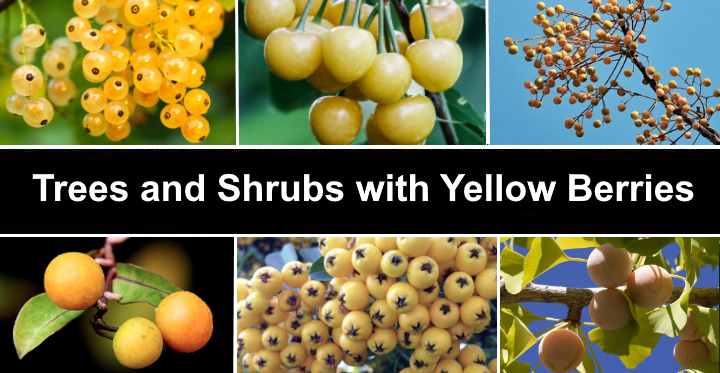
Trees and shrubs producing yellow berries enhance garden landscapes with vibrant, bright fruits. Typically growing in clusters, yellow berries contrast with dark green foliage on trees and shrubs. Additionally, shrubs and trees with yellow berries attract wildlife, providing birds a much-needed food source in fall and winter. Whether you choose a shade tree with yellow berries or a compact berry shrub with yellow fruits, these plants are ideal for landscaping a front or backyard.
A diverse range of landscaping trees and shrubs produce colorful yellow berries in the fall. For example, winterberry (Ilex verticillata) and golden firethorn (Pyracantha) are evergreen shrubs with cultivars producing yellow fruits. Also, many deciduous shrubs like yellow holly (Ilex aquifolium) and golden currant (Ribes aureum) have showy ripe berries in shades of yellows.
If you want to add a pop of golden yellow colors to your garden, consider incorporating trees and shrubs with yellow, showy berries. These can serve as a great focal point or enhance the overall aesthetic of your outdoor space.
This article is an identification guide to trees and shrubs with berries in various yellow shades.
Identification of Yellow Berries
To identify yellow berries on shrubs and trees, observe the plant’s branches, leaf shape, flower shape, bloom time, and growth habits. Some berry shrubs have clusters of small, rounded fruits. In contrast, other shrubs with berries have yellow drupes or pomes that look like berries. Also, some tree or shrub varieties produce berries in several colors.
Yellow Berries on Trees and Shrubs — Proceed with Caution
Exercise caution when consuming wild yellow berries, as some may be toxic. Lack of knowledge about specific species can lead to accidental ingestion of poisonous fruits, causing illness or harm. Therefore, you should always verify the edibility of wild yellow berries. If in doubt, it’s best to avoid eating unripe or ripe berries to avoid potential health risks.
Types of Trees and Shrubs with Yellow Berries — Identification Guide With Pictures
Trees and shrubs that produce yellow berries are rare in the botanical world. Many garden shrubs have yellow flowers but produce berries in various shades of red, blue, and white. However, winterberry, rowan, holly, and firethorn are showy shrubs with yellow berries.
Winterberry (Ilex verticillata ‘Berry Heavy Gold’)

The winterberry cultivar ‘Berry Heavy Gold’ is a deciduous holly shrub with vibrant golden yellow berries that persist through the winter months. The profusion of yellow berries appears on upright stems. The showy, ornamental holly shrub also has small, greenish-yellow flowers and lanceolate, dark green leaves with serrated margins.
‘Berry Heavy Gold’ is a shrub native to North America. It doesn’t grow taller than 8 ft. (2.4 m) tall and wide. Thanks to its beautiful foliage and masses of golden berries, winterberry adds color and interest to front and backyards throughout the year. This slow-growing deciduous shrub has an upright habit and rounded growth.
Its tolerance for wet or moist areas makes winterberry ideal for planting in bog gardens or along the edge of ponds or streams. It also performs well in full sun or part shade as a hedge, foundation planting, or focal point in a garden landscape. It’s a low-maintenance shrub, useful for easy-care landscapes, and resistant to many pests and diseases.
- USDA Planting Zones: 3 to 9
- Sunlight: Full sun to partial shade
- Mature Size: 6 to 8 ft. (1.8 – 2.4 m) tall and wide
Mountain ash (Sorbus ‘Joseph Rock’)

Mountain ash ‘Joseph Rock’ is a small, ornamental deciduous tree with a compact, upright habit and abundant butter-yellow fruits. The identifying features of the compact tree are its pinnate leaves with serrated edges, clusters of creamy white flowers blooming in spring, and vibrant pale yellow berries in the fall.
Mountain ash ‘Joseph Rock’ grows up to 30 ft. (9 m) tall. Its decorative foliage provides privacy and shade, and its berries attract birds in the fall. Younger trees have an upright habit before broadening into a vase shape.
This mountain ash cultivar prefers full sun and is drought-tolerant once established. Its compact size makes the decorative tree ideal for small gardens and urban areas. Apart from its yellow berries, it also provides notable fall interest when its leaves turn orange, purple, and red shades before dropping.
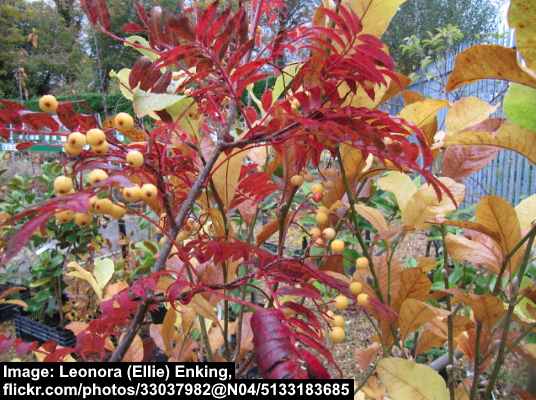
Mountain ash autumn foliage
Sorbus ‘Sunshine’ is another mountain ash cultivar with yellow berries. It’s a deciduous, easy-care shrub with an open-branched, upright growth habit. It has spectacular fall colors when its green foliage turns fiery red hues.
If you are looking for a columnar tree with yellow berries, then you can choose mountain ash ‘Autumn Spire’ (Sorbus ‘Autumn Spire’) which is a small tree with upright growth habit, summer white flowers and attractive autumn foliage.
- USDA Planting Zones: 7 and 8
- Sunlight: Full sun or light shade
- Mature Size: 15 to 30 ft. (4.5 – 9 m) tall and up to 20 ft. (6 m) wide.
Yellow Holly (Ilex aquifolium ‘Bacciflava’)

Yellow holly ‘Bacciflava’ is a tough large shrub or tree with glossy, spiny leaves and dense clusters of bright yellow berries in the fall. Outstanding features of this yellow-fruited holly variety are its evergreen foliage, jagged leaves, and white flowers in the spring. The golden berries are a valuable food source for birds during fall and winter.
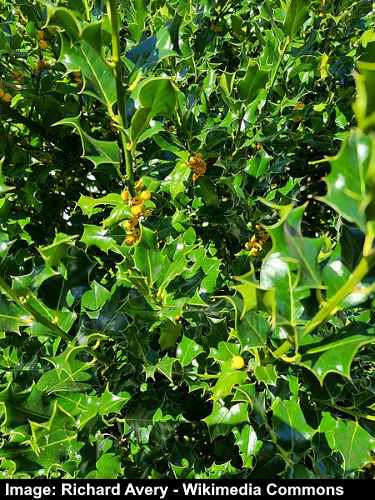
Yellow holly shrub
This ornamental holly variety is adaptable and can thrive in various soil types. Growing up to 13 feet (4 m), the shade-loving evergreen shrub is tolerant of dry and wet conditions once established.
Yellow holly grows well as an accent plant in gardens. Its tough branches and spiny, leathery leaves give various landscaping uses. It performs well when planted as a privacy screen, security barrier, or evergreen hedge. Its year-long aesthetic appeal makes it a valuable addition to garden landscapes.
- USDA Planting Zones: 6 to 9
- Sunlight: Full sun, partial shade, or deep shade
- Mature Size: 10 to 13 ft. (3 – 4 m) tall and up to 10 ft. (3 m) wide
Golden Firethorn (Pyracantha ‘Soleil d’OR’)

Golden firethorn is a thorny shrub with clusters of bright yellow-orange berries, white flowers, and evergreen foliage. This spiny shrub features glossy, dark green leaves, corymbs of brilliant white spring blossoms, and abundant clusters of small golden berries in the fall and winter. The small yellow or pale orange berries are approximately 0.25” (6 mm) in diameter.
This medium-sized shrub can grow up to 8 ft. (2.5 m) tall. Its dense growth habit and thorny branches make it an excellent choice for creating a privacy hedge or barrier. The golden berries add a vibrant splash of color to front or backyards and attract birds.
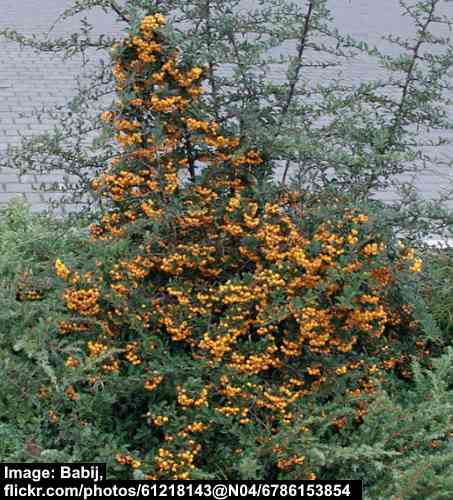
Golden firethorn shrub
Pyracantha soleil D’OR yellow berries and thorny branches make it ideal for planting as a privacy hedge, foundation planting, or security hedge. Additionally, it grows well as an espalier, windbreak, or ornamental accent.
Another Pyracantha firethorn hedge plant with yellow berries is the ‘Saphyr Yellow’ cultivar. This evergreen shrub grows up to 10 ft. (3 m) and blooms in late spring with bunches of small white flowers, followed by bright yellow berries in the fall.
- USDA Planting Zones: 6 to 9
- Sunlight: Full sun to partial shade
- Mature Size: 5 to 8 ft. (1.5 – 2.5 m) tall and 8 to 13 ft. (2.5 – 4 m) wide
Argan Tree (Argania Spinosa)

The Argan tree is a heat-loving thorny tree with yellow plum-sized fruits. The greenish-golden berries grow in small clusters after the tree finishes blooming in summer. The small evergreen tree has a gnarled trunk, green oval leaves, and five-petaled yellowish-green flowers. It’s an attractive tree growing up to 25 ft. (7.6 m) tall.
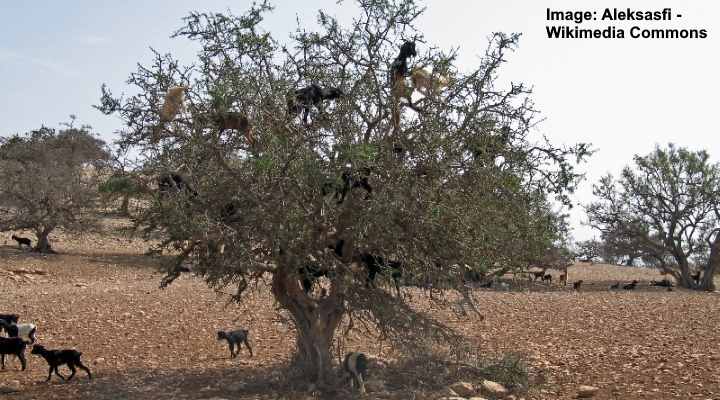
Argan tree
The Argan tree has a unique appearance, with twisted branches and a dense, spreading crown. The trees are drought-tolerant and perform well in dry soil. The berry-like yellow drupes have sweet-smelling pulp surrounding one to three hard nuts. The tree is famed for producing Argan oil from pressing the seeds.
Argan trees are popular ornamental trees in warm winter regions.
- USDA Planting Zone: 9 to 11
- Sunlight: Full sun
- Mature Size: 15 to 25 ft. (4.5 – 7.6 m) tall and up to 40 ft. (12 m) wide
Chinaberry Tree (Melia azedarach)

Chinaberry tree berries are golden yellow berry-like drupes when mature. This fast-growing ornamental tree has a unique appearance and interesting features. For example, it has a rounded crown, light gray bark, pinnately compound leaves, and star-shaped lilac flowers in spring and summer. It also has yellow foliage in the fall.
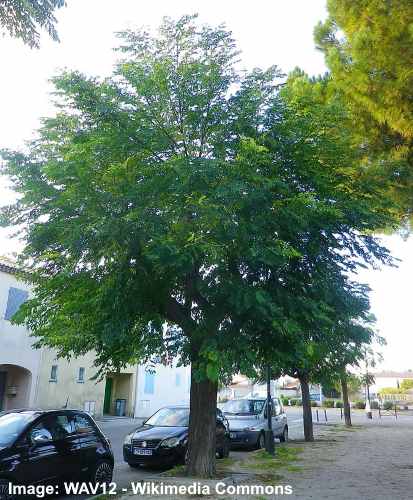
Chinaberry tree
The Chinaberry tree produces poisonous yellow fruits that look like wrinkled dates. The large tree grows up to 40 ft. (12 m) tall, and its rounded crown of dense foliage is ideal as a shade tree in warm climates.
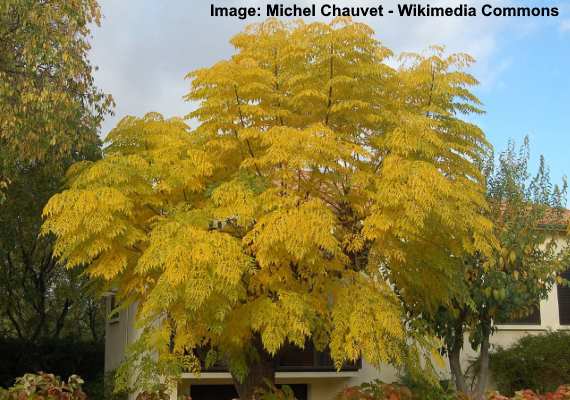
Chinaberry tree in autumn
When planting this tree near walkways or patios, it’s important to consider the potential mess from the dropping berries. Also, the tree has invasive tendencies, and its fruit is toxic to humans and animals.
- USDA Planting Zones: 7 to 10
- Sunlight: Full sun to partial shade
- Mature Size: 30 to 40 ft. (9 – 12 m) tall and wide
Sea Buckthorn (Hippophae rhamnoides)

Sea buckthorn is a shrub with clusters of pale yellow to deep orange berries and deciduous foliage. Identifying features of this thorny shrub are its deep brown or black bark, greenish flowers without petals, and narrow, silvery-green, lanceolate leaves. The flowers give way to abundant yellow or orange berry-like drupes in late summer.
Sea buckthorn is a spiny shrub with an irregular crown that grows up to 13 ft. (4 m). Its cold and salt spray tolerance makes it an ideal ornamental shrub in coastal regions. Also, its edible orange berries are a good source of vitamin C.
Sea buckthorn shrubs perform well in northern landscapes. You can plant the yellow-fruiting shrub as a privacy screen, windbreak, or foundation planting. Its nitrogen-fixing ability and extensive root system help to improve soil quality and prevent erosion.
- USDA Planting Zone: 3 to 7
- Sunlight: Full sun
- Mature Size: 5 – 13 ft. (2 to 4 m) tall and wide
The Golden Raindrops Tree (Malus transitoria)

The golden raindrops tree is a small, yellow-fruiting deciduous tree with abundant golden-yellow berry-like pomes. This ornamental, single-trunked tree has a vase shape with spreading branches and deeply cut, lobed leaves. It blooms in spring with white flowers before they give way to masses of round yellow fruits.

A golden raindrops tree and a close up image of its flowers
The golden raindrops tree turns fall landscapes into warm orange and yellow shades. Its green leaves turn a spectacular orange hue, and its small fruits ripen from pale greenish-yellow to dark yellow or orange.
The ornamental crabapple tree has a moderate growth rate and reaches up to 20 ft. (6 m) tall. It’s known for its spreading growth that becomes rounded with age. This yellow-fruiting tree is ideal for small gardens as a standalone specimen tree.
- USDA Planting Zones: 3 to 8
- Sunlight: Full sun to partial shade
- Mature Size: 15 to 20 ft. (4.5 to 6 m) tall and 13 ft. (4 m) wide
Golden Currant (Ribes aureum)

Golden currant deciduous shrubs produce clusters of small, golden yellow currants that look like berries. The characteristic features of this thornless shrub are its bright green, lobed leaves, five-petaled yellow flowers, and abundant clusters of translucent, yellow fruits. The edible berries are slightly smaller than blueberries and have a sweet and tart flavor.
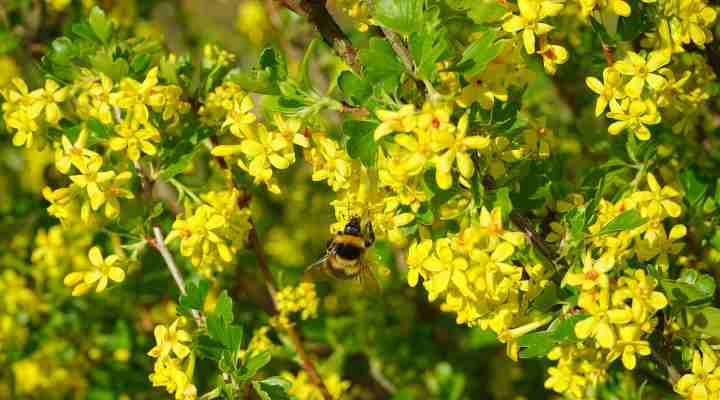
Golden currant flowers
Golden currant shrubs typically grow up to 10 ft. (3 m) tall. Native to North America, the yellow-fruiting shrub has pretty flowers that emit a vanilla or clove-like scent. Also, the ripe berries can range in color from yellow to orange, red, deep purple, and black.
Golden currant shrubs have various ornamental uses in landscaping. They grow well in full sun or part shade in borders, mass plantings, or as an informal hedge. You can also plant the shrub as part of a fruit garden. It is drought-tolerant once established.
- USDA Planting Zones: 5 to 8
- Sunlight: Full sun to partial shade
- Mature Size: 5 to 10 ft. (2 – 3 m) tall and wide
Yellow Cherries (Prunus avium)

Several varieties of cherry fruit trees produce yellow berry-like drupes. The small, round fruits grow in bundles, dangling from branches in late summer and fall. The tasty cherries can be golden yellow, purple, or burgundy red. Yellow cherries are typically smaller in size compared to traditional red cherries.
Yellow cherry trees like ‘Sweet Cherry,’ ‘Stark Golden Sweet,’ and ‘White Cherry Gold’ grow 15 to 25 ft. (4.5 – 7.6 m) tall. They bloom every spring with masses of beautiful white flowers when the leaves appear. The yellow fleshy drupes have a large stone surrounded by sweet, tasty flesh.
- USDA Planting Zones: 3 to 8
- Sunlight: Full sun
- Mature Size: 15 to 25 ft. (4.5 – 7.6 m) tall and up to 20 ft. (6 m) wide
Maidenhair Tree (Ginkgo biloba)

The maidenhair tree is one of the most beautiful trees that produces yellow berry-like seeds. This distinctive shade tree is known for its fan-shaped, leathery leaves and bright yellow foliage in the fall. This deciduous tree has a spreading, open crown and straight trunk, making it ideal as a tall shade tree.
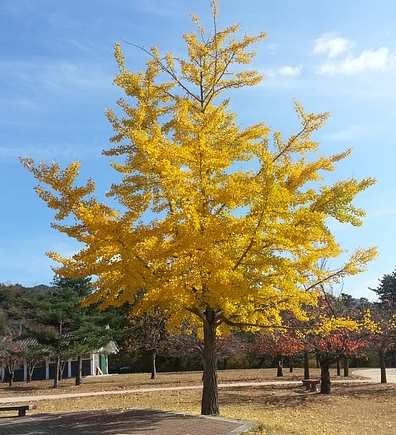
Ginkgo biloba ‘Autumn Gold’
Inconspicuous yellow-green flowers appear in the spring, followed by fruit-like, seed-containing structures 0.6” to 0.8” (1.5 – 2 cm) long. Immature Ginkgo biloba trees have a pyramidal habit that gradually becomes irregular as they age.
Due to its tall stature, maidenhair trees are ideal for planting in large landscapes and parks. Their tolerance to urban pollution makes them ideal street trees. They are also popular indoor trees with bonsai enthusiasts.
- USDA Planting Zones: 5 to 9
- Sunlight: Full sun
- Mature Size: 25 to 50 ft. (7.6 – 15 m) tall and up to 35 ft. (10 m) wide
Related articles:
